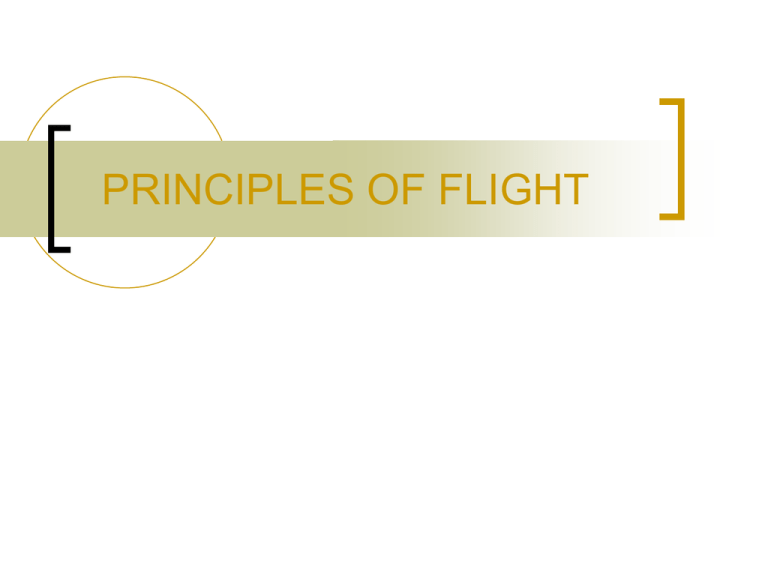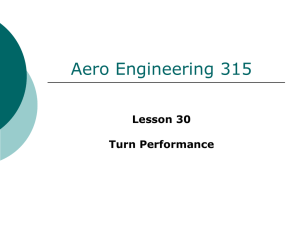Principle of flight
advertisement

PRINCIPLES OF FLIGHT DEFINITIONS Mass :- Mass is the quantity of matter in a body Density :- Density is the mass per unit volume. Pressure :- Pressure is the force per unit area. (Units:- lbs / sq inch) Momentum :- The quantity of motion in a body is known as momentum of the body and is equal to the product of mass and velocity (M = m x v) Motion :- When a body changes its position in relation to its surroundings. Speed :- Speed is the rate of change of position. Velocity :- Velocity is the speed in a particular direction. Velocity is a vector quantity having both magnitude and direction. Acceleration :- Acceleration is the rate of change of velocity. Work :- Work is said to be done on a body when a force acting on it physically moves the point of application in the direction of the force. Work done = Force x Distance moved in the direction of force (Units : Foot Pounds) Power :- Power is the rate of doing work. (One horse power is equals to 550 lbs/sec) Energy :- Energy is the capacity to do the work. Energy can exist in many forms i.e heat, light, electrical, sound, chemical, atomic, pressure, mechanical etc... Potential Energy :- Due to the position of a body above ground level. Potential Energy (PE) = Mgh Kinetic Energy :- Due to the motion in the body. Kinetic Energy (KE) = ½ mv² Couple :- A couple consists of two equal, opposite and parallel forces not acting through the same point. Equilibrium :- A body is said to be in equilibrium when (a) Algebraic sum of all the forces acting on the body is zero. (b) Clockwise moment is equal to the anticlockwise moment about any point. Boyles’ Law :- The volume of a given mass of a perfect gas is inversely proportional to the pressure, provided the temperature remains constant. p x v = constant (temp unchanged) Charles’ Law :- The volume of a perfect gas increases by 1/273 of its value at 0°C for every degree C rise in temperature, provided the pressure remains constant. Laws Of Motion Newton’s First Law Of Motion :- A body which is in a state of rest or of its uniform motion will continue to be in the same state unless an external force is applied upon it. This property of all bodies is called inertia and a body in such a state is said to be in equilibrium. Newton’s Second Law Of Motion :The rate of change of momentum of a body is directly proportional to the applied force and takes place in the direction of the application of the said force. Newton’s Third Law Of Motion :- To every action, there is an equal and opposite reaction. GLOSSARY OF TERMS Aerofoil :- A body is designed to produce more lift than drag. A typical aerofoil section which is cambered on top surface and is more or less straight at bottom surface. Chord Line :- It is a line joining the centre of curvature of leading and trailing edges of an aerofoil section. Chord Length :- It is the length of chord line intercepted between the leading and trailing edges. Angle Of Attack :- It is the angle between the chord line and the relative airflow undisturbed by the presence of aerofoil. Angle Of Incidence :- The angle between the chord line and the longitudinal axis of the aircraft. Angle of Incidence :- The angle between the chord line and the longitudinal axis of the aircraft. Total Reaction :- It is a single force representing all the pressures ( force per unit area ) over the surface of the aerofoil. It acts through the centre of pressure which is situated on the chord line. Lift :- The vertical component of total reaction resolved at right angles to the relative air flow. Drag :- The horizontal component of the total reaction acting parallel and in the same direction as the relative airflow. ATMOSPHERE Introduction : The word Atmosphere is derived from the Greek ‘Atoms’ means ‘vapour’ and ‘phere’ means ‘sphere’. Atmosphere means the gaseous sphere surrounding the earth. Composition : Air is a mixture of number of gases consisting of :Nitrogen Oxygen Argon CO2 and other gases - 78.03 % 20.99 % 00.94 % - 00.04 % Apart from the above gases air also contains some impurities like dust and salt particles. Water vapour and traces of other gases are also present. Divisions Of Atmosphere : The atmosphere is divided in four main regions :- Tropo Sphere Strato Sphere Iono Sphere Exo Sphere Tropo Sphere :- It extends from the surface to a height of about 9 km near the poles and 17 km near the equator. Tropo pause:- Tropo pause is the dividing line between Tropo Sphere and Strato Sphere. Strato Sphere :It extends from the Tropopause upto a height of about 3 km. Iono Sphere :- Above Stratosphere, it extends upto a height of 24 km. Exo Sphere :- It extends from Ionosphere upto a height of 1126.5 km. Temperature : The temperature of earth’s surface depends almost entirely upon the heat received from the sun. As a rule, temperature decreases with height. The hotter the earth’s surface becomes, more readily it radiates its heat back again to space. Heat is transferred by three methods i.e. (i) Conduction (ii) Convection and (iii) Radiation The instrument used for measuring temperature is called thermometer and the units of measure is either “Fahrenheit” or “Centigrade” in degrees. Variation of Temp with Height: In the atmosphere the temperature as a rule decreases with height. Lapse rate :- The decrease of temperature with height is known as “Lapse” and the rate of decrease is known as “Lapse Rate”. Air Density : The density of air is defined as the mass of the air contained in unit volume and is measured in “grams per cubic meter”. Presence of water vapour in the atmosphere decreases the air density. Also the air density decreases if pressure decreases or its temperature increases. Variation of Density : Variation of air density at the surface :- At the surface, variations of air density are due to temperature variations. When temperature is maximum, air density is minimum and viceversa. Variation of density with height :- Air density decreases with height mainly due to the effect of the pressure. The decrease in air density with height due to fall in pressure is much more than the increase in air density due to fall in temperature with height. BERNAULI’s THEOREM & VENTURI EFFECT Bernauli’s Theorem :In the early days of the Industrial revolution, Daniel Bernauli, an Italian physicist, discovered certain properties relating to fluids in motion, which he summarized as follows:The total energy in a moving fluid is the total sum of three forms of energy i.e. Potential, Kinetic and Pressure Energy. In a stream line flow of an ideal fluid, the sum of all these three energies remains constant. Venturi Tube :- A tube which has inlet portion gradually narrowing then a throat or neck followed by an out let which widens gradually is called a venturi tube or convergent / divergent duct. Venturi Tube :- Venturi effect and Bernauli’s Theorem : In the previous chapter, we have seen that for a flow of air to remain streamlined, the volume passing at a given point in unit time’ must remain constant. If a venturi tube is placed in such an air stream, then the mass flow in the venturi tube must also remain constant and streamlined. In order to achieve this and still pass through the restricted section of the venturi, and accompanying pressure drop is a natural consequence according to Bernauli’s theorem. Therefore when a wing moves through the air, the pressure on the upper surface is less than atmospheric and more than atmospheric on the bottom surface. This pressure difference existing between the top and bottom surface, is the main lifting force of a flying aircraft. Venturi Effect : When a stream line air flow is passing through a venturi tube the mass flow remains constant at all points in the tube. Since the cross sectional area at throat is less, to maintain the constant air flow either the air should get compressed or it should speed up. It almost behaves like an incompressible fluid and therefore speeds up. Its kinetic energy is increased and therefore according to Bernauli’s theorem the pressure energy drops. This phenomenon is called Venturi Effect. FORCES ACTING ON AIRCRAFT Introduction :- An aircraft is considered to be in straight and level flight when it is flying at a constant altitude and speed, maintaining lateral level and direction. Forces Acting on Aircraft : Weight Lift Thrust Drag Direction of Flight Lift Thrust CP CG Weight Drag Weight :- Weight of the aircraft acting vertically downwards through C.G Lift :- Lift acting vertically upwards through C.P Thrust :- Thrust acting horizontally forward along the propeller shaft. Drag :- Drag acting horizontally backwards along the line of total drag of the aircraft. Forces acting on straight and level flight : Weight :- Weight of the aircraft acting vertically downwards through C.G Lift :- Lift acting vertically upwards through C.P Thrust :- Thrust acting horizontally forward along the propeller shaft. Drag :- Drag acting horizontally backwards along the line of total drag of the aircraft. Equilibrium : In a straight and level flight, the following conditions must be satisfied for equilibrium. (a) Algebraic sum of forces acting horizontally = 0 (b) Algebraic sum of forces acting vertically = 0 It follows that L = W and T = D. At any instant, the weight of an aircraft is a certain quantity and the aircraft is flown at such an angle of attack and air speed that it produces lift equal to weight. Under these conditions, the aircraft has certain amount of drag which is counteracted by the pilot adjusting his engine controls so that T = D The position of CG is always kept ahead of the CP so that if the engine cuts, the aircraft assumes a gliding attitude without difficulty. GLIDE Glide :- Glide is that condition of flight in which the aircraft is losing height without power at a constant speed maintaining lateral level and direction. Gliding Angle :- Gliding angle is the angle between earth’s horizon and the path of the aircraft. Forces Acting On Glide : The forces acting on an aircraft in a glide are Weight Lift Drag Weight :- Weight acting vertically down wards. Lift :- Lift acting at right angles to the glide path. Drag :- Drag acting backwards along the glide path. Gliding Speed : It has been shown that the angle of glide is the least when L/D is maximum. Thus if we fly at a speed corresponding to the optimum angle of attack, we will get the flattest glide. This speed is the best gliding speed given in the pilots notes for the aircraft. Gliding at any speed higher or lower than this speed will mean a reduction in L/D ratio and hence the glide path will be steeper. LIFT Lift : The lift (L) is the force which acts on the main plane vertically upwards through the centre of pressure. It helps in taking off the aircraft from the ground and then to maintain the aircraft in level flight. The shape of an aerofoil is such that it is convex on top side and more or less plain on the bottom side. When the aircraft moves on the forward direction, the air coming from front side of aircraft passes over the aircraft. Due to the curve nature of the aerofoil, the velocity of incoming air is much more on top side as compared to the bottom side. As a result of this the pressure on the top side decreases as compared to the bottom side. Consequently the aerofoil is being lifted due to the high pressure on the bottom side. Factors Governing Lift : The different factors governing the lift of an aerofoil are as follows :(a) Angle of attack (b) The air speed (c) Area of aerofoil (d) Density of air Angle of attack :- It is defined as the angle between the chord line and the relative air flow. If it is properly adjusted that is at angle between 3° and 4°, the lift will be maximum. Air Speed :- It is the speed of airflow over the aerofoil. When the air speed is more over the aerofoil, the pressure decreases considerably and the lift is more convenient. Area of the Aerofoil :- It is the total area of an aerofoil over which the air passes. By increasing the surface area to the airflow the lift can be increased. Density of Air :- As the pressure is directly proportional to the density, a difference in pressure gives rise to the difference in density of air on both the side of an aerofoil. If the difference is more then the lift also will be more. DRAG Drag : The drag (D) is the force which acts horizontally backwards. It is the resistive force of the incoming airflow from the front side of an aircraft which retard the forward motion of the aircraft. It is an unwanted force which tries to reduce the thrust of an aircraft. The greater the drag, the greater is the power needed to over come it. For an economical flight every effort must be taken to reduce the drag. Factors Affecting Drag : The different factors affecting drag are as follows :(a) The shape of the body (b) The surface (c) Frontal area of the body exposed (d) Square of the velocity of the airflow (e) The density of the air (f) The acceleration due to gravity The shape of the body :- The shape of the aircraft is made in such a way that minimum portion of the body is exposed to the airflow. It helps in reducing the drag. The Surface :- The less is the surface exposed to the airflow, the less will be the drag. Frontal area of the body exposed :The frontal area of the body is made in such a way that it is a streamlined one which will reduce the drag. Velocity of airflow :- The force due to drag is directly proportional to the square of the velocity of the airflow. In order to minimise the drag, the aircraft is flown when the velocity of the airflow is less. Density of Air :- The aircraft is made to fly in the air, when its density is relatively low due to the changing weather condition in order to reduce the drag. Acceleration due to Gravity :- When the aircraft is made to fly in a less height that is under the influence of acceleration due to gravity, then the drag is minimum. CLIMB Climb : Introduction :A climb is that condition of flight in which an aircraft gains altitude at a steady rate and a constant airspeed maintaining lateral level and direction Forces Acting in a Climb : The forces acting on an aircraft during a climb are as follows :(a) (b) (c) (e) Weight (W) Lift (L) Drag (D) Thrust (T) Weight :- Weight acting vertically downwards. Lift :- Lift acting at right angles to the path of climb. Drag :- Drag acting backwards along the path of climb. Thrust :- Thrust acting forward along the path of climb. Ceiling : Service aircrafts are required to give their best efficiency at certain pre - determined operating altitudes and the engine, propeller and aircraft are designed accordingly. The rate of climb is an important factor in its consideration. Beyond its best operating altitude, an aircraft can climb upto its service ceiling where its rate of climb drops off to a predetermined rate (normally 100'/min). The absolute ceiling of an aircraft is that altitude beyond which the aircraft will not climb. At this altitude, there is only one possible level speed and the power required to fly straight and level is equal to the power available from the engine. Effect of Wind : When an aircraft is climbing, the wind effects its path of climb in relation to the ground. When climbing in to wind, the ground speed being less greater height is gained for the same amount of ground covered than if the climb were made down wind. Hence a better obstacle clearance when near the ground. STALL AND SPIN How an aircraft stalls : From the airflow pattern observed over an aerofoil at varying angles of attack, it is observed that beyond 15° (approx) angle of attack, the airflow over the top surface breaks up and the turbulent airflow spreads over to the leading edge from the trailing edge. The CP moves, suddenly back at this stage, and the aircraft nose drops, in spite of all efforts to keep it up. This phenomenon, where the aircraft is out of control along with a sudden loss of height by an increase in angle of attack is called a STALL. Stalling Angle : The angle of attack at which the lift of an aerofoil is maximum and beyond which there is a sudden loss in lift and rapid increase in drag due to airflow over the aerofoil becoming turbulent instead of remaining streamlined, is called the ‘Stalling Angle’. Symptoms of Stall : The following symptoms indicate the approach of stall :(a) High attitude (b) Decreasing speed (c) Sluggish controls (d) Sink (e) Nose drop (f) Wing drop High attitude :- As the pilot keeps on increasing the angle of attack in trying to maintain height. Decreasing Speed :- Due to increase in drag as a result of increase in angle of attack. Sluggish controls :- All controls start becoming less effective as the speed is decreased. Sink :- Just after the point of stall, the lift obtained from the wing decreases and sink may be felt. Nose drop :- Inspite of the pilot trying to ease back on the stick, the nose drops, because the CP moves sharply back, thus causing the nose to go down. Wing drop :- In some aircrafts it occurs because one wing stalls just before the other one. This can also be due to slight yaw at the point of stall. Recovery from stall : (a) The obvious method is to decrease the angle of attack by easing the stick forward. (b) Use of power will effect a much quicker recovery with a much lesser loss of height. Types of stall : Stalls can be generalized under the following three main headings :(a) Basic Stall (b) Shock Stall (c) High speed Stall Basic Stall :- It can be further sub-divided as follows : (i) Stall : Clean aircraft (ii) Stall : With flaps and under carriage down (iii) Stall with power on. Shock Stall :- This occurs at very high Mach numbers due to compressibility effects. Here the angle of attack can be any figure. Recovery action lies in lowering the Mach No. High Speed Stall :- The aircraft can, in fact, stall in any attitude relative to the horizon as it is the relative flow that is significant and which gives the angle of attack. The aircraft thus can be made to stall in a climb, in glide, in turn, in fact any time when the wings are presented at the stalling angle to the airflow. Further, harsh movement of stick can also result in a stall at any speed. To recover, the backward pressure on the stick must be relaxed. SPINNING : Introduction :Spinning is that stalled condition of flight in which the aircraft rapidly loses height in a spiral path while auto-rotating and autopitching. Conditions for a Spin : Mishandling of controls at the point of stall causes a spin. A yaw at the point of stall initiates a spin. A yaw will cause a wing drop and auto rotation begins. An aircraft can get into a spin from any attitude of flight. e.g.: gliding turn, steep turn, aerobatics... An aircraft however, does not go directly from a stall into a spin. It is a transition period, the duration of which varies considerably with different conditions of stall in some type of aircraft, and also with different conditions of stall in some type of aircraft. When a wing drops at the point of stall, the aircraft nose begins to yaw towards the dropped wing, and as the angle of bank increases, it will drop sharply below the horizon and the aircraft begins a spiral decent. The condition immediately precedes the spin and is referred to as an INCIPIENT SPIN. Auto Pitching : In a spin, the aircraft is auto-pitching. As the aircraft stalls, the centre of pressure moves rapidly back causing the nose of the aircraft to drop. Then the CP tends to move forward causing the nose to move up and this keeps repeating as long as the aircraft is spinning. This is called AUTO-PITCHING. The following points about spinning are worth noting :Use of power during recovery will only increase the loss of height and if the spin was initiated with power, the throttle should be closed. Use of aileron is undesirable during a spin, because if used in the natural sense, they increase the drag on the inner wing and tend to keep the aircraft in the spin. LIFT AUGMENTATION Introduction : The problem of augmenting (increasing) the maximum lift co-efficient to the speed of the lower speed range aircrafts has always been as much attention as the search for the high speeds. The use of high speed aerofoil sections helps the designer to achieve higher speed by reducing the drag. As most aircrafts using these aerofoils also have high wing loading, the stalling speed are proportionately higher. This requires longer landing run. Lift augmentation devices : The following are the chief devices used to augment the lift co-efficient : (a) Slats (b) Flaps (c) Boundary layer control Slats : Slats are the small auxiliary aerofoil surfaces of highly cambered section is fixed to the leading edge of the wing along the complete span and adjusted so that a suitable slot is formed between the two. The lift coefficient is increased by so much as 70% and more. At the same time the stalling angle is increased by 10°. Types of slats : There are mainly three types of slats: (a) Fixed Slats (b) Controlled Slats (c) Automatic Slats Fixed Slats :- In this case the slats are kept permanently opened with a slot and it was found that the extra drag at a high speed would be a greater disadvantage than the advantage gained by the extra lift at low speeds. Controlled Slats :- In this the slats would be moved to open the slot and close the slot by control mechanism attached to a lever in the cockpit which gains the advantage at high and low speeds. Automatic Slats :- In this case when the slat is not in use it lies flush against the edge of the wings. At high angles of attack the low pressure peak near the leading edge of the upper surface of the wing and the lift generated by the cambered slot itself lift the slat upward and forwards to the open position, thus forming the required slot. Flaps : Introduction :- The plain or cambered flap works on the same principle as on aileron or other control surface, it is truly a ‘variable camber’. Flaps, like slats can also increase the drag. Lowering of flaps produce an increase in the lift co-efficient at given speed but at the same time the greater camber also causes an increase in the total drag. The best lift drag ratio is obtained with the flap at some angle between 15° and 35°. Types of Flaps : There are various types of flaps in use and they are mainly :(a) Plain or Camber Flaps (b) Split Flaps (c) Slotted Flaps (d) Fowler Flaps (e) Jet Flaps (f) Zap Flaps (g) Variable camber Flaps STABILITY Stability : Introduction :- Stability of aircraft means its ability to return some particular condition of flight (after having been slightly disturbed from that condition) without any effort on the part of the pilot. The stability of an aircraft can be defined as its tendency to return to the original trimmed position after having been displaced. The term is applicable in all the three axes of rotation. i.e. longitudinal, lateral, and normal. The three Axes of Aircraft : An aircraft can rotate about three axes at right angles to each other. The three axes are: (a) Longitudinal Axis (b) Lateral Axis (c) Normal Axis FLYING CONTROLS Longitudinal Axis : The axis running fore and aft through Centre of gravity is known as the longitudinal axis of the aircraft. (or) It is the axis passes through Centre of Gravity of the aircraft and runs from nose to tail of the aircraft is called longitudinal axis of the aircraft. This is the axis about which aircraft rolls. The stability about this axis is known as lateral stability. Lateral Axis : The lateral axis is a line running span wise through the CG at the right angles to the other Longitudinal and Normal axis. Movement about this axis is Pitching. Stability about this axis is called longitudinal stability. Normal Axis : The normal or directional axis is a line running vertically through Centre of Gravity and at right angles to both lateral and longitudinal axis. Stability about this axis is known as directional stability. It is the axis about which aircraft yaws. The stability of an aircraft so far as it concerns pitching about the lateral axis is called longitudinal stability. The stability which concerns rolling about the longitudinal axis is called lateral stability. The stability which concerns the yawing about the normal axis is called the directional stability. Factors governing Longitudinal Stability : The three main facts which influence longitudinal stability are :(a) Position of Centre of Gravity (b) Movement of Centre of pressure (c) Design of the Tailplane & Elevators. Position of Centre of Gravity : An aircraft is most stable at its forward limit of CG. If this forward. If this forward position is exceeded, the stick forces become very high and often create undue fatigue to the pilot. As the CG position is increased back, the stability decreases with lesser tendency of the aircraft to returns to its original trimmed position after having been disturbed. Movement of CP : The position of Centre of pressure depends upon the angle of attack. The CP moves forward with increase in angle of attack and backward when the angle of attack decreases. It also follows that since the aircraft rotates around its CG, if the CP moves ahead of the CG, a nose up movement will result. Similarly, a nose down change of trim will occur if the CP moves back of the CG. Design of Tailplane and Elevator : The function of the tailplane is to provide a countering force to any residual out of balance force existing among the four main forces. If the angle of attack is increased due to any reason the wing lift is also increased and the CP tends to move forward. As a result the state of equilibrium no longer exists. It also follows that the tailplane has been subjected to same increase in the angle of attack. In order to restore the aircraft to its original trimmed position, the role of the tail plane comes to play, which is so designed that the increase in tailplane lift is greater than the unbalancing moment caused by the above mentioned disturbance Lateral Stability : If the aircraft regains the lateral level, after initial disturbance, it is said to be laterally stable. Lateral stability is obtained by one or a combination of the following methods. Factors Governing Lateral Stability: (a) Dihedral Angle (b) Sweepback of the wings Placing most keel surface above the CG Using a high wing and low CG position. Dihedral Angle : When a wing is inclined upwards from its lateral axis, the angle from the horizontal is known as dihedral angle. (Similarly the inclination below is called anhedral angle). It also follows that an a/c with a dihedral angle will have a higher angle of attack. When an a/c with a dihedral angle is banked, the tilted lift vector, initiates a side slipping action. Due to dihedral angle, the airflow meets the lower wing at a larger angle of attack than the higher wing, as a result the quantom of lift increases on the lower wing thus setting up a balancing movement to correct the bank. Sweepback Of Wings : A slide slip occurs when an a/c is banked, In case of an a/c with swept back wings, the lower wing offers a shorter effective chord with a greater effective camber than the raised wing. This results in a greater amount of lift on the lower wing which in turn restores lateral level. High Keel Surface : During a slide slip, a considerable amount of force is exerted on the keel surface (side surface) of the a/c, which results in a turning movement about the CG. If the keel surface above the CG, produce greater movement than below it, the same will result in a correcting movement which will assist in restoring lateral level. This can be achieved by placing more keel surface above the CG High Wing and Low CG: If the a/c with high wing side slips, a pendulous effect is created. During the side-slip, the drag of the wing above CG allows it to swing down till the time it is placed vertically below the lift thus restoring lateral level. Directional Stability : The effect of directional and lateral stability are very closely interlinked. A disturbance which involves only lateral stability, initially, will always involve directional stability during subsequent interactions. The purpose of the fin is to provide directional stability. With out a fin, an a/c will be directionally unstable because the CP of the tear shaped body is ahead of CG Factors governing Directional Stability: (a) Fin area (b) More keel surface behind the CG Fin Area :- When an a/c is disturbed on yawing plane the airflow for a movement continues to attach in the original direction. The fin having been located far behind the CG when affected by this airflow because of a long leverage provides a correcting movement tending to bring the a/c back into original path. More Keel Surface behind the CG:- In the lateral stability the keel surface above the CG level is considered, but in the directional stability the amount of keel surface behind the CG is important. Greater the surface behind the CG greater is the righting movement applied when affected directionally.








